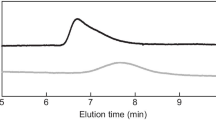Abstract
Halorubrum sp. SSR was isolated from a solar saltern in Algeria. The strain exhibited a high antibiotic activity against the indicator strain Natronorubrum aibiense G23, and the bioactive compound showed thermal, acid and alkali stability. SSR was grown on agar-supported cultivation (AgSF) to compare yields and applicability with traditional submerged cultivation. AgSF scale-up was implemented taking benefit from the solid-state cultivation prototype Platotex. This technology leads to high amounts of the target Halocin and facilitate the downstream steps. The antibiotic compound was purified according to a fast efficient procedure including ion exchange chromatography followed by a fractionation on C18 Sep-Pack cartridge. The compound was identified as Halocin C8 according to N-terminal amino acid sequencing and high-resolution mass spectrometry.





Similar content being viewed by others
References
Adelin E, Slimani N, Cortial S, Schmitz-Alfonso I, Ouazzani J (2010) Platotex: an innovative and fully automated device for cell growth scale-up of agar-supported solid-state fermentation. J Ind Microbiol Biotechnol 38:299–305
Adelin E, Servy C, Martin M-T, Arcile G, Iorga B, Retailleau P, Bonfill M, Ouazzani J (2014) Bicyclic and tetracyclic diterpenes from a Trichoderma symbiont of Taxus baccata. Phytochemistry 97:55–61
Le Goff G, Adelin E, Cortial S, Servy C, Ouazzani J et al (2013) Application of solid-phase extraction to agar-supported fermentation. Bioprocess Biosyst Eng 36:1285–1290
Li Y, Xiang H, Liu J, Zhou M, Tan H (2003) Purification and biological characterization of halocin C8, a novel peptide antibiotic from Halobacterium strain AS7092. Extremophiles 7:401–407
Mayr-Harting A, Hedges AJ, Berkeley RCW (1972) Methods for studying bacteriocins. In: Norris JR, Ribbons DW (ed) Methods in microbiology 7:315−422
Meghrous J, Lacroix C, Simar RE (1999) The effects on vegetative cells and spores of three bacteriocins from lactic acid bacteria. Food Microbiol 16:105–114
Price LB, Shand RF (2000) Halocin S8: a 36-amino-acid microhalocin from the Haloarchaeal strain S8a. J Bacteriol 182:4951–4958
Rodriguez-Valera F, Juez G, Kushner DJ (1982) Halocins: salt-dependent bacteriocins produced by extremely halophilic rods. Can J Microbiol 28:151–154
Sehgal SN, Gibbons NE (1960) Effect of metal ions on the growth of Halobacterium cutirubrum. Can J Microbiol 6:165–169
Shand RF (2006) Detection, quantification and purification of halocins: peptide antibiotics from haloarchaeal extremophiles. Methods in Microbiol 35:703–718
Subramaniyam R, Vimala R (2012) Solid state and submerged fermentation for the production of bioactive substances: a comparative study. Int J Sci Nat 3:480–486
Sun C, Li Y, Mei S, Lu Q, Zhou L, Xiang H (2005) A single gene directs both production and immunity of halocin C8 in a haloarchaeal strain AS7092. Mol Microbiol 57:537–549
Torreblanca M, Meseguer I, Rodriguez-Valera F (1989) Halocin H6, a bacteriocin from Haloferax gibbonsii. J Gen Microbiol 135:2661–2665
Tortorano AM, Cabrini E, Viviani MA (1979) Sensibilité in vitro des levures à cinq antibiotiques. Comparaison de deux méthodes C.M.I. en gélose et méthode des disques. Bull Soc Fr Myc Med 8:69–74
Author information
Authors and Affiliations
Corresponding author
Additional information
Communicated by A. Oren.
Rights and permissions
About this article
Cite this article
Meknaci, R., Lopes, P., Servy, C. et al. Agar-supported cultivation of Halorubrum sp. SSR, and production of halocin C8 on the scale-up prototype Platotex. Extremophiles 18, 1049–1055 (2014). https://doi.org/10.1007/s00792-014-0682-5
Received:
Accepted:
Published:
Issue Date:
DOI: https://doi.org/10.1007/s00792-014-0682-5




